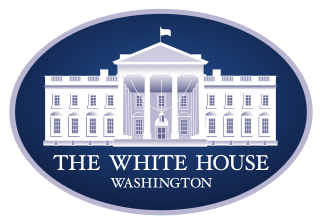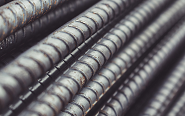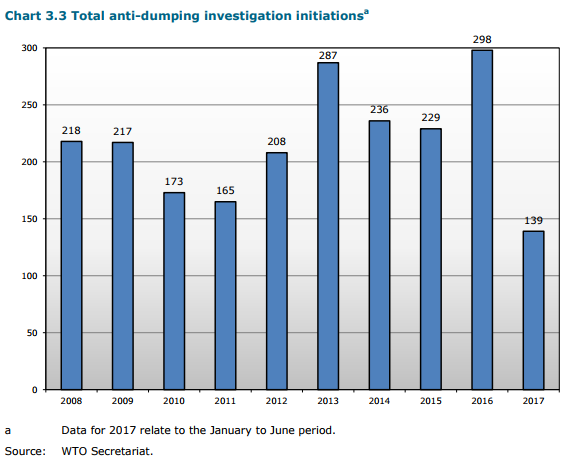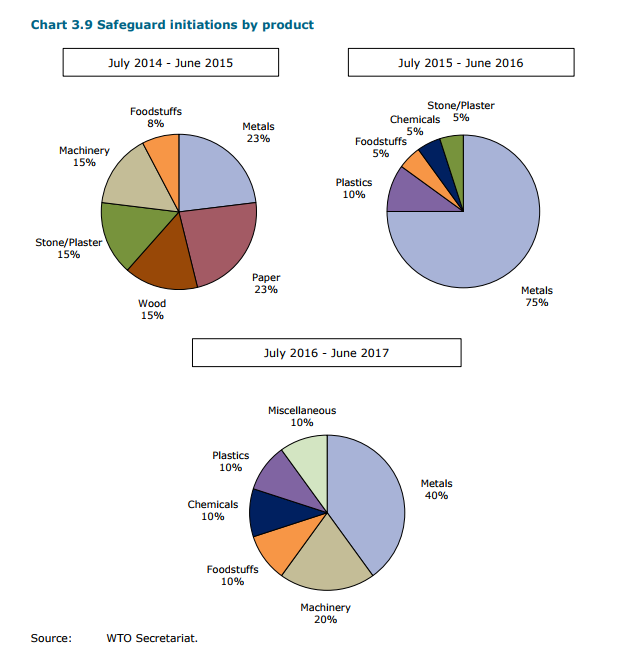Trade Cases

WTO: Trade Restrictive Measures Declining
Written by Sandy Williams
December 4, 2017
WTO members showed restraint in imposing trade restrictive measures last year, according to the organization’s most recent annual overview report on trade-related developments.
Members implemented 108 new trade-restrictive measures during the reporting period July 2016 through June 2017, an average of 9 measures per month compared to 15 per month in the previous annual report. Trade-restrictive measures include new or increased tariffs, customs procedures, quotas, and local content measure.
Measures that helped to promote trade declined during the past year. WTO reports that 128 measures aimed at facilitating trade were implemented, including eliminating or reducing tariffs and simplifying customs procedures. During the reporting period, implementation of trade-facilitating measures averaged 11 per month, down from 18 per month in the previous annual report.
Trade facilitating measures, however, outpaced trade restrictive measures, continuing a four-year trend. “It is noteworthy that the estimated trade coverage of import-facilitating measures ($169 billion) is more than two times larger than that of import-restricting measures ($79 billion),” wrote the WTO. “In addition, the import-facilitating measures implemented during the review period in the context of the expanded Information Technology Agreement (ITA) amounted to around $385 billion.”
Trade remedy measures, such as antidumping and countervailing duties and safeguard measures, showed a significant increase due to initiation of antidumping investigations. During the most recent reporting period, 290 investigations were initiated, up from 268 in the period July 2015-June 2016.
The chart below shows the total annual antidumping investigations that were initiated. The WTO notes that the 139 shown for 2017 cover from January to June of this year and may indicate a downward trend for the full year.
Metal products, especially steel, were subject to the most antidumping initiations in the last three July to June reporting periods. At least 86 antidumping investigations were initiated each year with 94 percent of those involving steel products. The U.S. initiated 73 AD investigations involving metals from June 2014 through June 2017, followed by Australia with 39, Canada 25 and Mexico 21.
The majority of antidumping investigations on steel products in the last three reporting periods were against China (79), followed by South Korea (34), India (19) and Vietnam (15).
Initiation of countervailing duty investigations remained constant at 36 in the last two reporting periods.
Most countervailing investigations are conducted concurrently with antidumping investigations. The WTO saw an increase in CVD initiations in the first half of 2017, which suggests the 2017 total may be higher than 2016.
Initiation of safeguard measures has been declining since 2014. In the June 2016-July 2017 reporting period, 10 safeguard investigations were initiated, down from 20 in the prior reporting period. From January-June 2017, five investigations were initiated, a figure that would seem to indicate a small further decline in 2017, said the WTO. The U.S. and China initiated safeguard investigations for the first time since 2001 and 2002, respectively.
Imposition of safeguard measures, however, nearly doubled in the last reporting period, jumping to 11 from six in the July 2015-June 2016 period.
Products targeted by safeguard initiations are illustrated by the charts below.
“The economic context for this year’s report is interesting, to say the least,” WTO Director-General Roberto Azevêdo said in his address to the Trade Policy Review Body. “International trade flows have rebounded strongly during the last 12 months after a sharp slowdown in 2016. In September, we upgraded our forecast for trade growth in 2017. This was due to a sharp acceleration in global trade growth in the first half of the year. The original forecast was 2.4 percent, and we are now forecasting growth of 3.6 percent.
“This improved outlook is very welcome, but substantial risks that threaten the world economy remain in place and could easily undermine any trade recovery. Looking ahead, we need to keep up the hard work to help facilitate trade. And, of course, this includes avoiding measures which can hamper and restrict trade flows.”

Sandy Williams
Read more from Sandy WilliamsLatest in Trade Cases

Price: Reciprocal tariff changes and potential new tariffs for Brazil, Canada, others
Trade issues do not seem poised to leave the headlines anytime soon. And as recent developments show, the administration’s tariff policy remains ever-changing.

Bessent on Vietnam: 20% tariff stands, Section 232 protections apply
US Treasury Secretary Scott Bessent told reporters that tariffs for Vietnamese imports to the US are 20% and "specific industries" have trade protections under the Section 232 tariffs.

Steel groups welcome passage of budget bill
Steel trade groups praised the passage of the Big Beautiful Bill (BBB) in Congress on Thursday.

Canada moves to curb steel imports with TRQs
Canada has implemented tariff-rate quotas (TRQs) on steel imports to help stabilize its domestic market.

Commerce launches probe into unfairly traded rebar imports
Here are the details and a case timeline for the rebar trade case recently initiated by the Commerce Department.


